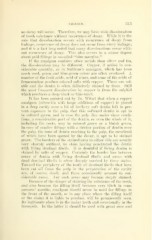Page 645 - My FlipBook
P. 645
AMALGAM. 315 ;
no decay will occur. Therefore, we may have wide discoloration
of tooth substance without recurrence of decay. While it is tlie
rule that discoloration occurs with recurrence of decay from
leakage, recurrence of decay does not occur from every leakage
and it is a fact long noted that many discolorations occur with-
out recurrence of decay. This also occurs in a minor degree
about gold fillings in so-called "blue margins."
If the amalgam contains other metals than silver and tin,
the discoloration may be different. Copper, if added in con-
siderable quantit.y, as in Sullivan's amalgam, which has been
much used, green and blue-green colors are often produced. A
number of the fruit acids, acid of wines, and some of the acids of
fermentation produce colored salts with copper. These are sol-
uble and the dentin is often diffusively stained by them. Still
the most frequent discoloration by copper is from the sulphid
which produces a deep black or blue-black.
It has been pointed out by Dr. Witzel that when a copper
amalgam (silver-tin with large additions of copper) is placed
in a deep cavity over a bit of leathery soft dentin left to pre-
vent exposure to the pulp, that this softened dentin is apt to
be colored green, and in case the pulp dies under these condi-
tions, a considerable part of the dentin, or even the whole of it,
including the roots, may be colored green or a bluish green.
In case of smaller fillings with a thicker portion of dentin over
the pulp, the cone of dentin reaching to the pulp, the canaliculi
of which have been opened by the decay, is apt to be stained
green. The borders of the stained area to either side are usually
very sharply outlined, no stain having penetrated the dentin
with living dentinal fibrils. It is doubtful if living dentin is
stained by salts of copper. Certainly the border line between
areas of dentin with living dentinal fibrils and areas with
dead dentinal filu'ils is often sharply marked by these stains.
Toward the periphery of the tooth all dentinal fibrils that have
been cut off from the jiulp in the preparation of the cavity
are, of course, dead; and these occasionally amount to con-
siderable areas. Any such areas may become deeply stained.
Because of the danger of staining the substance of the teeth,
and also because the filling itself becomes very black in some
persons' mouths, amalgam should never be used for fillings in
the front of the mouth, or in any place where the filling itself
or the stains it is liable to produce, will be prominently seen.
Its legitimate place is in the molar teeth and occasionally in the
bicuspids. In the latter it should be used with great care and


